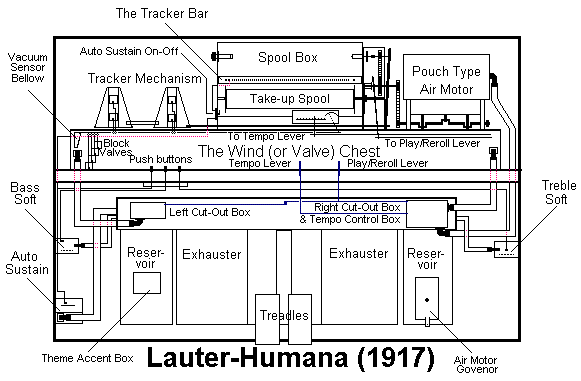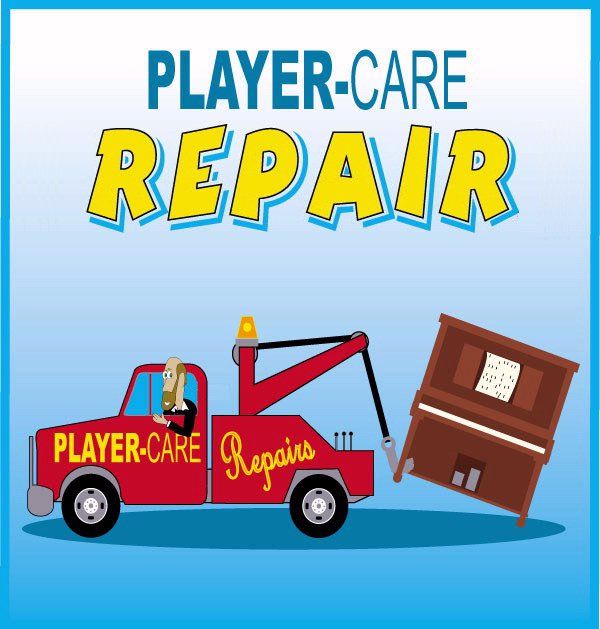
For more information about the Lauter-Humana - click here.
Explanation of Components
1. The Tracker Bar: Provides a means for 'reading' the perforations in a music roll. A series of 88 note holes which correspond to the 88 notes on the piano, in order from left to right (low bass to high treble).
2. Spool Box: Generally explained as the area that's visible behind the sliding doors above the piano keys. This is where the music roll goes.
3. Take-Up Spool: The spool onto which the music roll is wound as the roll is playing.
4. Pouch Type Air Motor: Provides the motive force that drives the music roll. Converts vacuum into mechanical movement.
5. Tracking Mechanism: Keeps the holes in the music roll properly aligned with the holes in the Tracker Bar. Automatically compensates for slight irregularities in the lateral position of the music roll.
6. Tempo Indicator: The Tempo Indicator is located in the Spool Box, directly under the Take-Up Spool. This is an "indicator" that shows how fast the music roll is moving across the Tracker Bar. No attempt should be made to adjust the Tempo of the music with the tempo pointer. (See Tempo Lever)
7. Tempo Lever: The Tempo Lever is located in front of the piano keys under the 'Flip-Board'. (See the video on the main Player-Care home page -click here. The piano in the video is a 1917 Lauter-Humana.) See Tempo Control Box below.
8. Push buttons: There are three push buttons. They are all spring-loaded and only work when they are being pressed down. From left to right, they are: Loud (Sustain), Bass (Soft), and Treble (Soft). They are generically referred to as "Expression Controls" because they allow the user to change the expression of the music by raising or lowering the volume of the music at the appropriate time/s (as dictated by the user).
.
The 'Loud' button is used to operate the Sustain feature. When pressed, any note that is played will 'ring on' until the button is released (or until the note stops ringing of its own volition). The 'Loud' button performs the same function as the Left piano pedal (or Sustain pedal). Most Lauter-Humana players also have an "Auto Sustain On-Off" switch in the Spool Box. See Auto Sustain On-Off
The "Bass" push button controls a device that moves the first 44 (starting at lowest note, A1) piano hammers closer to the piano strings. This reduces the 'blow distance', which causes the notes to sound quietly. This feature is typically called the "Bass Soft" feature. When used as a music roll is playing, all of the notes in the left side of the scale when sound softer than the notes on the right side. Typically, this allows the 'melody' to play louder than the 'accompaniment'. See Bass Soft
The "Treble" push button controls a device that moves the second 44 (starting at the middle note, F above middle C) piano hammers closer to the piano strings. This reduces the 'blow distance', which causes the notes to sound quietly. This feature is typically called the "Treble Soft" feature. When used as a music roll is playing, all of the notes in the right side of the scale when sound softer than the notes on the bass side. Typically, this allows the 'accompaniment' to play louder than the 'melody'. See Treble Soft
9. Key Lock Lever: (Not shown in diagram) This feature is found in some Lauter-Humana players, and is labeled 'Key Lock'. It is located between the Treble Soft button and the Tempo Lever. This lever is not spring loaded. It has two positions: On and Off. When moved to the Right, the Key Lock is engaged or 'On'. When in this position, a device under the keys moves Up and prevents the keys from being played. When the lever is moved to the left (or 'Off' position), the keys are free to move. The Key Lock can be used whether or not the player is being used. To read information about the debate concerning the need for a Key Lock in player pianos, click here. (Look for 'Key Lock Device in Upright Player Pianos')
10. Play/Reroll Lever: This lever is relatively self-explanatory. In the Play position, the music roll advances forward and the music plays. In the Reroll position, the music stops playing and the music roll rewinds.
11. The Wind (or Valve) Chest: This portion of the player piano system houses all of the block valves and pneumatics that are used to actuate the each of the 88 notes of the piano.
12. Exhauster: There are two Exhauster bellows. They are connected via linkage to the foot treadles. When the treadles are pushed, the exhauster bellows is forced open and that in turn sucks air out of the reservoir bellows. Stated in another way, forcing the exhauster bellows open creates a vacuum in the bellow. (Vacuum is what is used to operate a player piano.)
13. Reservoir: There are two reservoir bellows. They are connected via a common manifold to each other and to the two exhauster bellows. Each reservoir has a check valve that prevents the vacuum (generated by the exhauster bellows) from escaping back into the exhausters once it air has been sucked out of the reservoir. The purpose of the reservoir bellows is to store the vacuum that's created by the exhausters.
14. Left Cut-Out Box and Right Cut-Out Box: Inside of the left and right cut-out boxes are mechanical switches that are controlled by the movement of the Player/Reroll lever. In the Play position, the switches are open and in the Reroll position they are closed. The purpose of the switches is to allow air to flow from the wind chest to the reservoirs in Play and to prevent air from flowing from the wind chest to the reservoirs during Reroll. If air was allowed to flow from the wind chest to the reservoirs during reroll, the music would play backwards during the reroll cycle.
.
15. Tempo Control Box: The purpose of this device is to allow the user to vary the Tempo (or speed) of the music at any time. Inside the box is a graduated opening that is covered with a sliding wooden valve. The valve is moved by moving the Tempo Lever left or right. Moving the lever left will slow down the Tempo. Moving it right will speed up the Tempo. The Tempo Lever is also connected via linkage to the Tempo Indicator in the Spool Box. Most simply put, the tempo control box controls the vacuum that is used by the Air Motor.
.
16. Auto Sustain On-Off and Auto Sustain device: As explained above, in the information about the 'Loud' push button, the purpose of the Sustain feature is to allow the notes of the piano to 'ring on' or continue sounding after a note has been played. If this feature is activated continually, the music would sound very jumbled and unpleasant. However, used at the correct instances, it enhances to music by reducing the choppiness that's often associated with player piano music. Most music rolls after around 1914 incorporated an auto-sustain perforation, and the auto-sustain perforation was assigned a specific spot on the tracker bar. (Note the dotted red line under the tracker bar on the left hand end.) Some manufacturers, including Lauter, decided to include an Auto-Sustain On-Off switch inside the Spool Box which allows the user to turn the Auto-Sustain feature on or off at will. This switch might be labeled "Loud" or "Sustain". Left in the 'On' position, perforation in the music roll will activate the Auto-Sustain device (located in the lower left hand bottom of the piano) automatically and at the appropriate time for any particular music roll. In the 'Off' position, the user still has the ability to activate the Auto Sustain device via the 'Loud' push button (explained above)
.
17. Bass Soft device: This device, which is only controlled by the push button marked 'Bass', provides the force required to move half of the piano hammers closer to the piano strings.
.
18. Treble Soft device: This device, which is only controlled by the push button marked 'Treble', provides the force required to move half of the piano hammers closer to the piano strings.
19. Treadles: The foot treadles are pumped by the user to create the vacuum necessary to operate the player piano. Pushing on them slowly should make the music play quietly. Pushing on them quickly should cause an accent in the music. Pushing on them fast and hard should cause the music to play loudly. By varying the way the treadles are pushed, the user can control the expression (or life) of the music. A person who is accomplished at pumping the treadles in such a manner that the music sounds very 'life like' is called a "pianolist". Basically speaking, there is no right or wrong way to pump the treadles. It's basically up to the user. However, pumping the treadles hard and fast for an extended period of time will cause the entire player system and the entire piano action to wear out prematurely.
.
Lauter-Humana Serial Numbers/History
LAUTER CO., Est. 1862, by S. D. Lauter as a music store. Lauter passed away
in 1885 and Charles E. Cameron, Sr. assumed management. Cameron started
manufacturing the Lauter piano. Made Lauter grands, uprights and the Lauter
- Humana players. Offices and warerooms 657-659 Broad Street and factory at
58 - 68 Lackawanna Ave., Newark, New Jersey. Last office and factory at
Sussex Ave. and Duryee St., Newark, NJ. It is published that after the Great
Depression the Lauter Co. continued under the management of C. E. Cameron,
Sr. and then from 1936 to 1966 by his son Charles E. Cameron, Jr. It is said
that Lauter continued to make pianos until 1962 or 1963 and that the last retail
store, on Sussex Ave., closed in 1966. Also made Lenox and Llewellyn pianos.
1895-9000 1906-22300 1913-31400 1920-39000 1927-53400
1900-14300 1907-23900 1914-32400 1921-40600 1928-55200
1901-15500 1908-25400 1915-33400 1922-42400 1929-56600
1902-16700 1909-26800 1916-34400 1923-44400
1903-17900 1910-28100 1917-35400 1924-46600
1904-19300 1911-29300 1918-36400 1925-49000
1905-20700 1912-30400 1919-37600 1926-51400
|
| 






